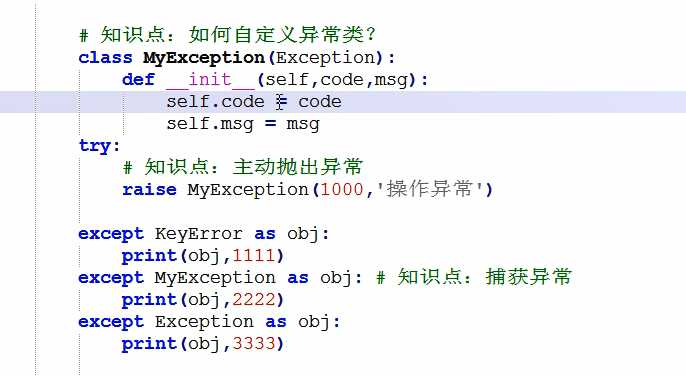标签:idt basic critical 多个 bst none src ima hfs
1.约束
class BaseMessage(object): def send(self,x1): """ 必须继承BaseMessage,然后其中必须编写send方法。用于完成具体业务逻辑。 """ raise NotImplementedError(".send() 必须被重写.")
class Email(BaseMessage):
def send(self,x1):
"""
必须继承BaseMessage,然后其中必须编写send方法。用于完成具体业务逻辑。
"""
pass
obj = Email()
obj.send(1)
开头定义一个约束函数,声明后边函数所使用的方法,主动抛异常raise NotImplementedError("方法(), ")
抽象类和抽象方法的约束
接口中不允许写代码,只能约束,继承他的类,必须实现接口中定义的所有方法
Java中:interface Foo:
def f1(self,x1):pass#表示类中必须继承f1方法。可以实现多个接口。
###抽象类,约束继承他的派生类必须实现它其中的抽象方法
abstact class Foo:
def f1(self):
print(1,3,4)
abstact def f2(self):pass#抽象方法
class Bar(Foo):
def f2(self):
print(123)
###Bar继承了Foo,就必须继承他的抽象方法,但是抽象类中的正常方法f1可以不用继承
python中的抽象类和抽象方法:
from abc import ABCMeta,abstractmethod class Base(metaclass=ABCMeta):#抽象类 def f1(self): print(123) @absabstractmethod#抽象方法 def f2(self): pass class Foo(Base): def f2(self): print(666) obj = Foo() obj.f1() obj.f2()
总结:
1.什么是接口以及作用?
是一种数据类型,主要用与约束派生类中必须实现的指定方法,python中没有,Java和c#存在
2.python中使用什么来约束?
抽象类+抽象方法 编写上比较麻烦。
人为的主动抛出异常
3.约束时,抛出的异常可以使用其他方法
专业的写法:raise NotImplementedError(".send() 必须被重写.")
4.应用场景:多个类,内部必须有某些方法是是,需要使用基类加异常进行约束。
自定义异常:
以前的方法:
try:
a=a1
except Exception as e:
print(e)
函数方法:
在文件中找关键字prev
import os def func(path,prev) response={"colde":1000,"data:None} try: if not os.path.exists(path): response["code"]=1001 response["data"]="文件不存在" return response if onto prev: response["code"]=1002 response["data"]="关键字为空" return response except Exception as e : response["code"]=1003 response["data"]="未知错误" return response
面向对象 import os class ExistsError(Exception): pass class KeyInvalidError(Exception): pass def new_func(path,prev): """ 去path路径的文件中,找到前缀为prev的一行数据,获取数据并返回给调用者。 1000,成功 1001,文件不存在 1002,关键字为空 1003,未知错误 ... :return: """ response = {‘code‘:1000,‘data‘:None} try: if not os.path.exists(path): raise ExistsError() if not prev: raise KeyInvalidError() pass except ExistsError as e: response[‘code‘] = 1001 response[‘data‘] = ‘文件不存在‘ except KeyInvalidError as e: response[‘code‘] = 1002 response[‘data‘] = ‘关键字为空‘ except Exception as e: response[‘code‘] = 1003 response[‘data‘] = ‘未知错误‘ return response

加密:
引入hashlib模块(帮助加密)
obj=hashilb.md5(b"fhfshsjhjksd")#加盐
obj.update("admin".enode("utf-8))
v=obj.hexdigest()
print(v)
为防止撞库,使用加盐
日志:
引入模块logging
import logging logger =logging.basicConfig(filename=‘日志.txt‘, format=‘%(asctime)s - %(name)s - %(levelname)s -%(module)s: %(message)s‘, datefmt=‘%Y-%m-%d %H:%M:%S‘, level=30) logging.debug("x1")#10 logging.info("2")#20 logging.warning("x3")#30 logging.error("x4")#40 logging.critical("x5")#50 # # logging.log(10,"x6") import traceback****************************** def func(): try: a=a+1 except Exception as e :#获取到堆栈信息 msg=traceback.format_exc() logging.error(msg) func()
标签:idt basic critical 多个 bst none src ima hfs
原文地址:https://www.cnblogs.com/wqzn/p/9568580.html